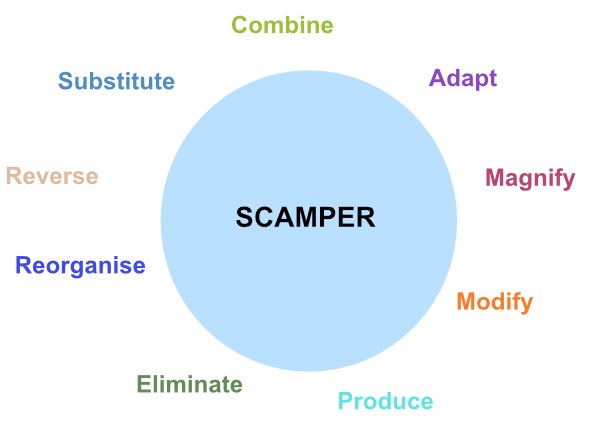How can you use the SCAMPER method ?
Which verbs are hidden behind this abbreviation ?
Origin
Before going through any method, it is always interesting to better understand its origin, so it is with the SCAMPER. It was first created in the 50s’ by the advertising executive and author Mr. Alex Faickney Osborn, and developed further in the 70s’ in Mr. Bob Eberle’s book. This approach has similarities which more traditional tools of Brainstorming and can be also perceived as a simplified version of the TRIZ.
As you might have already understood, the SCAMPER method is used during an ideation session and more effective if applied collaboratively. one of its main characteristics (which is also its main resemblance with the TRIZ) is the structure is follows, quite different to the reverse brainstorming for instance. This of course does not mean that the procedure is better or worse than another one, yet just that companies will appreciate it differently, depending on their internal culture. In other words, the goal is not that you use all the various tools of creativity available, yet find the one that is the most appropriate for you.
Use
The process for the SCAMPER is straightforward. To complete it, you will need to use each letter of the word, which are nothing else than the first letters of diverse verbs. it means that each letter (or each verb) has a question related to it, to which you have to answer. However, before doing that there is a guidline you will have to respect, in order to use the method properly :
- First, identify the object / problem / idea that you want to solve.
- Then, create a main question that will help you to formulate your research.
- Now, answer to the SCAMPER questions.
- Finally, select the best / chosen ideas, which seem feasible to you.
S.C.A.M.P.E.R.

- Substitute : What can be replaced ? who else ? what else ? (replace an element by another)
- Combine : What can we combine to multiply the possible uses ? (merge the ideas / concepts together)
- Adapt : Is there a similar product / service already existing ? (copy something that exists)
- Magnify : What can we add ? time ? power ? height ? length ? (magnify, enlarge or extand)
- Modify : Can we modify the product / service ? (its signification, color, movement, noise, smell, shape, etc.)
- Produce : Does other possible usabilities exist if we modify the product / service ?
- Éliminate : Can we substract ? delete ? decrease ? (eliminate some elements that are not necessary)
- Reorganise : Are there other settings to consider ? (use other sequences, or other orders of settings)
- Renverse : Can it be fliped over ? (reverse the negative by positive, the low by the high, and vice-versa)
As previously described, this method should be done in groups. However, if the whole team analyses each verb all together, it might take you a while before finishing the exercise. For this reason, we recommend you to make small groups, which will have to answer to their assigned SCAMPER questions. After that. they will share their results with all the teams, to then be able to move forward.
Before really starting the session, there is however a question behind the following verb that you need to ask yourself -> wait : what are you waiting for, to start using the SCAMPER method ?